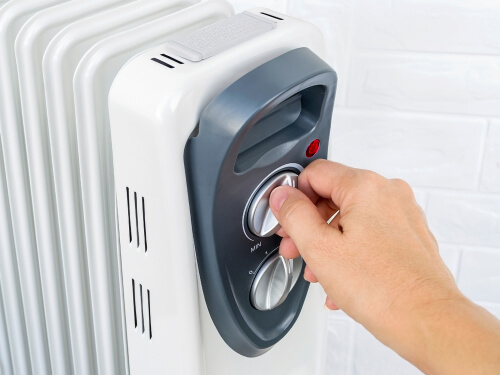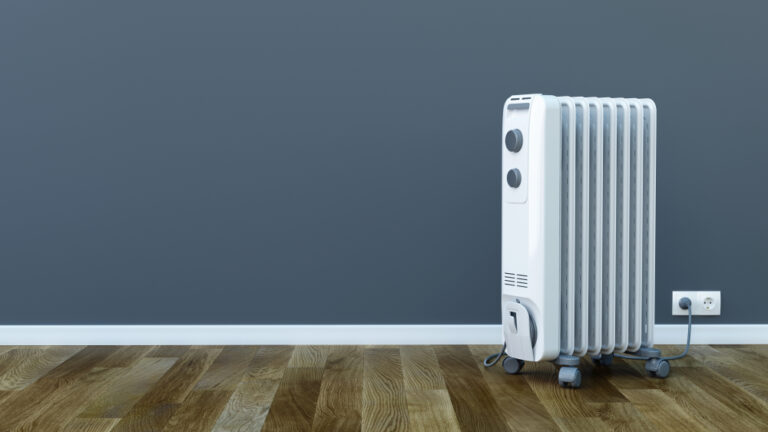These are currently the cheapest to run oil-filled radiators you can use today to keep you and your family warm as the cold weather sets in over the UK.
In this article, we’ll go over the running costs during peak and off-peak hours, and we’ll take a look at how to pick the most economical radiator for your home, office, or garage.
Best energy-efficient radiators for your home or office
These are the most energy-efficient oil heaters you can run in your room. You can customize the warmth according to your preference with their different power settings and adjustable thermostats.
Russell Hobbs 650w 4 Fin
Ideal for small box rooms and offices.
Up to 17p p/hour
- Max 650w
- Thermostat
- Overheat protection
- Black or White
Warmlite 1500w Oil Filled 7 Fin
Best for small to medium-sized rooms.
Low 15p High 39p
- 600w, 900w, 1500w
- Thermostat
- Safety tip-over switch
- Off-White or White
De’Longhi Dragon 4 2500w
Best for any large room or garage.
Low 18p High 65p
- Max 2500w
- Illuminating LED Display
- Intelligent Selection of Comfort Settings
- Temperature-Based Regulation
- Improved Heat Distribution
De’Longhi 500w Oil Heater
Best for under-desk heating and small rooms.
Up to 13p p/hour
- Max 500w
- Thermostat
- Built-in Overheat Protection
- Anti-Frost Feature for Added Security
- Color: White
What are oil-filled radiators?
An oil-filled radiator, also known as an oil heater, space heater, or column heater, is a type of convector heater people use in their homes, patios, and garages.
They’re portable, filled with oil, and usually, come on caster wheels for easy movement throughout rooms.
Once connected to the mains, the electricity heats the oil, which heats the surrounding air. The oil is used as a heat reservoir rather than being used as a fuel.
Efficiency
Typically, oil-filled radiators range in power from around 500 watts at their lowest consumption to 2900 watts. However, even when turned off, they’ll still kick out heat for a good hour while using no electricity at all.
Setting the thermostat on a 500-watt heater will take twice as long to reach the temperature as a 1000-watt, yet the overall amount of electricity consumed will be the same for both.
Although cheap to run, oil heaters are less efficient than heaters that consume gas. yet, gas heaters can not be used in closed environments due to the reduced oxygen from a burning flame.
Safety and features
Dangers to consider with any heater will always be the risk of fire or burns. Oil heaters come with a built-in tip-over safety switch that will turn off the radiator if it is knocked over, this makes them safer than both electric fan and halogen devices.
It’s always best practice to avoid having anything within 3 feet of any active heater and avoid drying damp clothes by laying them over the heated fins.
Some oil heaters come with a fan that companies have made to pull in cold air from around the room. This will increase the speed it takes to balance your room temperatures.
Which oil-filled radiator do I need?
You’ll need to know the size of your rooms if you want to use an oil heater. A room too big will result in waiting around while the heater attempts to deal with the amount of cooler air around it.
A small room with a powerful heater is fine as it will heat quickly. Set by its thermostat, it will easily control your overall room temperature by retaining the temperature you set it at.
Insulation
The size of your heater needed will depend on how well or how poorly your room is insulated.
Does the room have doors with gaps and no draught excluders, large windows, and poorly insulated walls? If so, these rooms will need a higher-powered heater to combat those draughty breezes.
Look at the table below to get an idea of the size oil radiator you’ll need to warm your room. These are the sizes in watts your heater will need to be to control your rooms temperature.
| Room Size (Square Feet) | Power in watts (Poor Insulation) | Power in watts (Good Insulation) |
| 20 | 250 | 250 |
| 40 | 500 | 500 |
| 60 | 750 | 500 |
| 80 | 1000 | 750 |
| 100 | 1250 | 1000 |
| 120 | 1500 | 1000 |
| 140 | 1750 | 1250 |
| 160 | 2000 | 1500 |
| 180 | 2250 | 1750 |
| 200 | 2500 | 2000 |
How much does it cost to run an oil filled radiator per hour?
According to the Ofgem, the price cap (as of 1st October 2025) will be just over 26 pence per kilowatt for electricity in the UK.
Your energy provider will charge you for each unit of electricity you use. In other words, for each kilowatt-hour (kWh) consumed.
Let’s take this price and apply the maths to see how much energy we’re consuming per hour, this will give us all the information needed to choose the cheapest to run oil-filled radiators.
I’ll be using the De’longhi portable oil heater in this example because of its low-running 500-watt power setting.
And with the price per kilowatt currently set at 26 pence, this is what you can expect to be spending:
| Setting | Power (watts) | Cost per hour |
| Lowest | 500 | 13p |
| Low | 1000 | 26p |
| Medium | 1500 | 39p |
| High | 2500 | 65p |

Running costs during off-peak hours
Off-peak rates will depend on which supplier you are with, but usually, it’s a 7 hour window set between the hours of 11 pm to 8 am.
All household electrical items such as washing machines, fridge freezers, tumble dryers, and heaters will benefit from lower running costs during this time.
From the 1st of October to December 30th, 2025 a discounted unit rate from most suppliers will be just over 10p/kWh for electricity during off-peak times. Now let’s see how much price difference it costs to run the heater mentioned above during these times:
| Setting | Power (watts) | Cost per hour (peak) | Cost per hour (off-peak) |
| Lowest | 500 | 13p | 8p |
| Low | 1000 | 26p | 16p |
| Medium | 1500 | 39p | 24p |
| High | 2500 | 65p | 40p |
As shown above, if you used this heater on the lowest 500 watt setting for 1 hour a night during off-peak times, you would be spending just 8 pence per day on your energy, that’s only 56 pence a week to heat your room.
However, a 53.68 pence daily standing charge will also apply to all households. So you will need to calculate this if you’re trying to work out the exact figures.
With these figures now explained and knowing what you spend currently on your energy, you should be able to work out how much you’ll be saving from running one.
Do oil-filled radiators use a lot of electricity per hour?
If you’re running a 1000-watts to 2500-watts radiator and it’s currently on the lowest setting, you can expect to be running in the lower range of 1000-watts (1 kilowatt per hour).
Running the heater on its highest setting will require more electricity to heat the oil faster, and you’ll be using the maximum 2500-watts (2.5 kilowatts per hour).
But the amount of electricity they use depends on how you plan to use them.
A lower 500-watt oil radiator might sound cheaper to run, but it also might not be enough to heat the size of your room on its lowest setting.
Setting your radiator accordingly
Oil heaters come with a control dial so you can choose to run the heater on a low, medium, or higher setting.
Some also have a built-in thermostat that lets you regulate the temperature of your room, so there’s no need to leave it on low while you sleep.
Try setting the thermostat to somewhere between 15°C and 20°C so you feel comfortable getting out of bed in the morning.

Is it cheaper to run an oil-filled radiator than gas central heating?
According to Choose, gas central heating for a typical 24 (kWh) boiler will cost approximately 91p an hour to run.
A 1000-watt radiator running on its highest setting will cost around 26p an hour, or 16p an hour (off-peak).
However, central heating is suitable for heating all the rooms in your house together. Meanwhile, an oil-filled radiator is best suited for adjusting the temperature in any single room, whether that might be a bedroom, living room, conservatory, or garage.
Read more on the benefits of running an oil-filled heater.
Are oil-filled radiators cheaper to run than convector heaters?
Oil heaters are superior when comparing the two for energy consumption and safe usage.
Convector heaters consume around 2000-watts (2kWh) of electricity, which is often more than double the energy usage of an oil-filled radiator.
Also, once turned off, the convector heater will not radiate any more heat, unlike the oil radiator, which will continue to warm the surrounding air as the oil slowly cools to room temperature.
And within this time, you’re not spending a single penny on your energy!
More FAQ’s
They can be if you leave them on full power for long periods. Take advantage of the lower settings as well as running the heater during off-peak hours to make the most from it.
Peak hours: 39p on its highest setting which will use the full 1500-watts.
Off Peak: 24p.
Peak hours: 52p on its highest setting which will use the full 2000-watts.
Off-peak: 32p.
Final thoughts:
These are the cheapest to run oil-filled radiators people use to keep warm without using more energy than they need to.
Oil-filled radiators are a cheaper-to-use alternative when comparing them to other heating devices.
They’re made to be energy efficient in the way they work, and ones that run from or below 1000-watts are the most economical electric heaters you can currently use.
They don’t require the same high power surges to heat internal elements and blow out hot air as fan or halogen heaters do.






